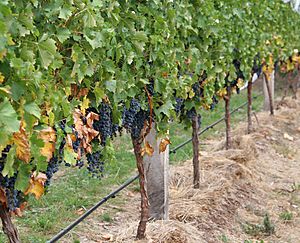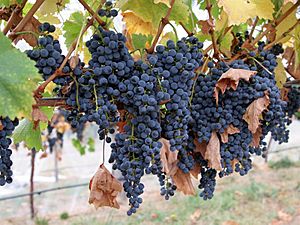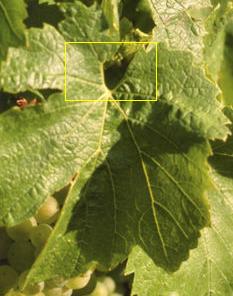Canopy (grape) facts for kids
The canopy of a grapevine is everything you see above the ground. It includes the trunk, cordons (arms), stems, leaves, flowers, and the grapes themselves. This part of the vine is super important! It helps the plant capture sunlight for photosynthesis, which is how plants make their food. It also controls how much water the vine uses and helps create the perfect tiny climate around the ripening grapes.
Managing the canopy, called canopy management, is a big job for grape growers. It affects how many grapes grow (the yield), how good they taste, and how strong the vine is. Good canopy management also helps prevent grape diseases. Problems like grapes ripening unevenly, sunburn, or frost damage can be fixed with smart canopy care. Growers often prune and trim leaves. They also train the canopy on trellis systems. This guides the vine's growth and makes it easier to care for and harvest the grapes.
Contents
The Grapevine's Trunk
The trunk is the main part of the grapevine. It grows from the root system in the ground up to the cordons, which are like the vine's arms. When a grape plant is young, its trunk is very bendy. It needs stakes to support it as part of a vine training system.
The height of the trunk can be different. It depends on the type of grape variety and the trellis system used. Trunks can be anywhere from 4 inches (10 cm) to 30 feet (10 m) tall. In winter, when it's very cold, the trunk can get hurt by freezing temperatures. Sometimes, growers bury the trunk in soil to keep it safe and warm.
The trunk has special tubes inside it, called tissues. The most important ones are the phloem and xylem. The outside bark of the vine holds the phloem tissues. These tissues carry sap full of sugars and other good stuff from the leaves to the rest of the vine.
During the grapevine's yearly growth, the vine stores energy (carbohydrates) in the wood of its trunk and roots. Growers can sometimes stop the phloem sap from going down to the roots. This is done by a process called "girdling" or cincturing. This can help the vine send more energy to the grape clusters, making them develop better. The xylem is the woody tissue inside the trunk. It moves sap, full of water, minerals, and other things, from the roots up to the leaves.
Cordon: The Vine's Arms
The cordon, also known as the "arms" of the grapevine, grows out from the trunk. This is where new arms, leaves, and grape clusters will grow. Cordons are usually trained along wires as part of a trellis system. This training often keeps the cordon in a set position. For example, they might extend straight out from the trunk in opposite directions.
Stems and Shoots
People sometimes use the words "stem," "stalk," and "shoot" to mean the same thing. However, grape experts (viticulturalists) use them a bit differently. The stem of the grapevine that grows from the cordon is called a shoot. These shoots are often trimmed in a process called "shoot thinning." This helps control how many grapes the vine produces.
The stalk that holds a whole bunch of grapes is called the bunchstem. The tiny stem of a single grape berry is called the pedicel.
Shoots grow from new buds on the cordon. They grow to include leaves, tendrils, and later, grape clusters. Shoots first appear in spring after bud break. They grow very fast until the flowering stage. Their growth usually slows down when the vine starts veraison. During veraison (which is usually in mid to late summer), the shoot begins to get hard and changes color from green to brown.
Cane: A Ripening Shoot
At this point, the ripening shoot becomes known as a "cane." In winter, the canes of the grapevine are usually cut off completely. The amount and weight of the cut canes help growers decide how much pruning and canopy management is needed for the next year.
The "tip" of the shoot is the very end, about 0.4 inches (1 cm) long. Grape experts watch the growth of this tip. It tells them how strong the vine is. This is because the tip competes with the grape clusters for the vine's resources. Ideally, shoot growth should stop around the time of veraison. If a vine keeps growing shoots, it might mean the grape clusters won't develop as fully.
Leaves: The Vine's Powerhouses
A grapevine's leaves are the most noticeable part of the canopy. They are also one of the most important. It's through the leaves that the vital physiological process of photosynthesis happens. This process creates the carbohydrates (food) the vine needs to grow and ripen its grape clusters.
The size of leaves changes depending on the grape variety. For example, Merlot vines have very large leaves, while Gewürztraminer is known for having small leaves. A typical leaf size is usually similar to a human hand. Besides size, leaves have many other unique features. Experts who study grapevines, called ampelographers, use these features to identify different plants.
They look at the size and shape of the leaf's sinus. This is the open space where the leaf blade connects to the petiole. They also check the shape of the "teeth" along the outer edge. The way the five lobes (projecting parts) are arranged is also important. Even the angle and length of the veins can help identify the grapevine.
The color of the leaf can show how healthy and well-fed the vine is. Chlorophyll in the leaf gives it a natural green color. Before winter, the vine stops making food through photosynthesis. This causes the chlorophyll to break down naturally, and the leaves change color. However, if a vine turns yellow too early (like before harvest), it could mean it doesn't have enough nitrogen or sulfur. Reddish spots or brown "dead zones" might be signs of a viral infection, like the leafroll virus. They could also be from contamination by herbicides.
Grape growers use a leaf to fruit ratio to figure out if a vine can fully ripen its grapes. This is different from just thinking about how many grapes there are. The right balance of leaf cover (for photosynthesis) and the amount of fruit (judged by weight, not just number of clusters) can greatly affect the quality of the grapes for winemaking.
A grape expert named Richard Smart came up with the idea of a "balanced vine." This means having just enough leaves for the plant to make the energy needed to ripen the grapes. But it's also important not to have too much leaf activity. If there's too much, the vine might have extra energy and keep growing more shoots instead of focusing on the grapes.
Also, leaves provide shade for the grape clusters. This can be good for protecting the grapes from harsh heat ("sunburn"). But too much shade can also slow down the development of sugars, anthocyanins (color), and other important compounds in the grape. Many vineyards remove some leaves throughout the growing season. They do this to try and keep the perfect amount of leaf coverage.





